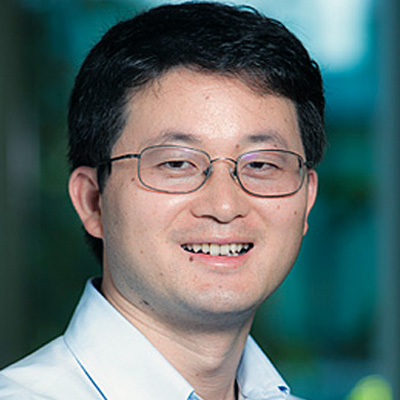Using the body as camouflage against itself for more effective therapies
Dr. Liangfang Zhang, Professor in the Department of Nanoengineering and the Moores Cancer Center at the University of California, San Diego is creating cutting-edge biomimetic nanotechnologies, nanostructures that mimic the properties and functions of live cells and organisms, and exploiting them to study and solve complex biological problems. This technology wraps man-made nanoparticles with natural biological material taken directly from the cells and organisms. In 2011, Dr. Zhang was the first to invent cell membrane-coated nanoparticle technology, which has now evolved as an emerging research field. Specifically, he developed an entirely new red blood cell (RBC) membrane camouflaging technique to disguise synthetic drug delivery nanoparticles as natural RBCs. By cloaking nanoparticles with cellular membranes derived directly from natural RBCs, these nanoparticles are naturally equipped with all of the immune-related proteins presented on RBC membranes, and can therefore evade the body's immune system for prolonged and more effective drug delivery. This work represents the first attempt to combine natural cellular membranes with synthetic nanomaterials to develop novel biomimetic drug delivery systems. It opens a whole new set of opportunities for the society of nanotechnology and materials science. We are urgently looking for new treatments to some of life's most pressing medical conditions, particularly cancers and antibiotic-resistant bacterial infections, and Dr. Zhang is revolutionizing the way we fight these diseases with his technology. These are critical, unmet medical challenges that threaten the public health and demand bold and innovative solutions.
Dr. Liangfang Zhang, Principal Investigator of the Nanomaterials and Nanomedicine Laboratory and Co-Director of the Center for Engineering in Cancer at the University of California, San Diego, has invented a method of coating nanoparticles, or miniscule synthetic materials and devices used in a variety of applications, with already existent biological materials for decreased rates of rejection by the host immune system. The proposed cell membrane-coated nanoparticle technology is entirely new and holds great promise to meet the demands for treatment of serious life-threatening diseases, namely cancers and antibiotic-resistant infections. Stripping the cell's functional surface membranes and applying them to nanotechnology represents an intriguing approach toward building a cell-mimicking nanodevice. Through this platform technology, multiple surface proteins of a natural cell can be faithfully transferred to a synthetic nanoparticle without causing them to interfere with one another. Coating nanoparticles with cell membranes is extremely promising for enabling a series of biomedicine deliveries. These include but are not limited to: evading the body's immune system for extended circulation to effectively deliver therapeutic payloads; absorbing a wide range of bacteria-secreted virulence factors, or toxins, for the treatment of pathogenic infections; and replicating the entire tumor surface antigens to develop cancer treatment vaccines. Collectively, the impact of the proposed research program is far-reaching and can influence many aspects of biological and medical research.
Dr. Zhang has had significant successes following initial studies. Current research projects include:
-
Camouflaged Nanoparticles for Drug Delivery: The development of drug carriers with long systemic circulation lifetime has long been one of the major goals in the field of drug delivery. Long-circulating drug carriers can more effectively localize to the disease sites, such as tumors and cardiovascular lesions, through either passive or active targeting mechanisms. Dr. Zhang created an entirely new biomimetic nanoparticle platform by cloaking synthetic nanoparticles with the cellular membranes extracted directly from a host's natural red blood cells (RBCs). Because the nanoparticles are equipped with all of the immunomodulatory proteins that are naturally found in the RBC's external membrane, they can evade the body's immune system for extended periods of time, continuing to circulate unnoticed through the bloodstream, effectively delivering their chemical payload (medicine) as they circulate. Comparing this technology to a soldier, this interesting and novel approach is equivalent to adorning a soldier in the uniform of his enemy, and allowing him to infiltrate an enemy camp and effectively dispose of the evildoers. This RBC membrane coating approach opens a whole new set of opportunities for the nanotechnology and nanomedicine communities.
-
Antimicrobial Nanotherapeutics for Infectious Diseases: The emergence of antibiotic-resistant bacteria strains has prompted concerted efforts among scientists and physicians to develop strategic plans to combat these increasingly problematic infectious pathogens. Dr. Zhang is exploring novel nanotherapeutics for the treatment of infectious bacteria, with a specific focus on methicillin-resistant Staphylococcus aureus (MRSA) infection and Helicobacter pylori (H. pylori) infection. As one example, he is developing a novel, broadly applicable toxin-absorbing nanoparticle platform (also called 'toxin nanosponge'). Consisting of a polymeric nanoparticle core wrapped by natural RBC membranes, the toxin nanosponge functions as a decoy to absorb and neutralize various types of pore-forming toxins secreted by pathogenic bacteria and thus divert the toxins away from natural target cells. The disarming of bacteria by removing their toxin is analogous to removing a soldier's weapons; without his weapons he is no longer able to cause harm. The toxin nanosponge technique provides an unprecedented opportunity in addressing the formidable treatment challenge presented by the arsenal of staphylococcal membrane-damaging virulence factors. In addition, this approach also reduces the selective pressure for further antibiotic resistance because the technology is designed to "disarm" bacteria and then let the immune cells to take over the powerless pathogens; thereby no antibiotics are involved in the treatment.
- Personalized Cancer Immunotherapy: It is increasingly being understood that, in order for a nascent tumor to grow, it must overcome myriad mechanisms that the immune system has in place for detecting and eliminating aberrant cells. Growing tumors must reduce their immunogenicity, allowing them to thrive in the face of the body's own defenses. Dr. Zhang is creating a personalized strategy for developing potent vaccines that will utilize the body's natural mechanisms for fighting cancerous cells by re-activating the immune system to recognize and attack cancerous cells. This will be accomplished by coating nanoparticle cores loaded with immunological adjuvants, or immune system promoters, with membrane material derived from cancer cells. The resulting cancer cell membrane-coated nanoparticles contain all of the components necessary to generate a robust immune response against the source cancer cells. This is similar to using technology to identify rogue or treasonous soldiers within an army. Adorning nanoparticles with the entire cell membrane of a cancerous cell will assist the immune system in identifying antigens, or immune system triggers, eliminating the need for identifying individual antigens of cancerous cells. This greatly increases efficiency while presenting a novel and specific therapeutic in the fight against cancer.
Bio
When Dr. Zhang was working toward his doctoral degree at the University of Illinois at Urbana-Champaign, he had the opportunity to work alongside the very respected professor, Dr. Steve Granick, a true scientist who focused on the details and who introduced Dr. Zhang to the field of research, instilling in him an appreciation for fundamental scientific research. After completing his Ph.D., Dr. Zhang went to MIT and worked with Professor Robert Langer, a chemical engineer who has perfected translational research, or the combining of fundamental laboratory research with practical applications. This idea of making laboratory discoveries useful for practical applications interested and inspired Dr. Zhang, leading him to seek ways to push technological development in a more practical way.
His personal goal as a researcher is to develop technologies that can be used to improve the overall quality of life in patients. At his own lab, Dr. Zhang has set out to develop novel technology designed to directly help patients, and is choosing diseases where treatment is urgently needed, such as cancers and infections caused by antibiotic-resistant bacteria. Since joining the University of California, San Diego, he has focused on implementing engineering principles in developing novel nanotherapeutics to treat cancers and infectious diseases.
Dr. Zhang is further motivated by the patient and community interest and response in and to his work. In one instance, Dr. Zhang published a paper in a purely scientific journal, and received an email the next morning from a person outside the scientific community who had read his paper and was following up with questions about the details of his technology. They were particularly interested in the stage of development, and when the tools would be ready for use in him or her and his or her family members. This revealed to him that the general public do really care about research and the technological solutions to current problems, which motivated him to develop new technologies that could be used beyond the lab. Most of the work Dr. Zhang does in his lab is translational research. It is not enough to perform good scientific research; all new technologies need to be pushed to clinical trial. This is the only way to ensure technological breakthroughs leading to real product development that can benefit the patient community.
Outside of the lab, Dr. Zhang remains active through exercise: although he no longer plays basketball as frequently as he did in his youth, he is an avid walker who enjoys the benefits of the stimulating activity. When he is not working or walking, Dr. Zhang is an avid reader who enjoys many different genres of literature.
In the News
Jacobs School of Engineering
Science Nation
Technology Review
Technology Review


